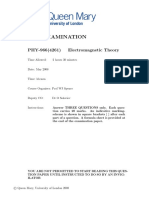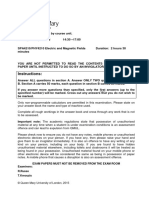0 ratings0% found this document useful (0 votes)
20 viewsEMT6SUP
EMT6SUP
Uploaded by
zcaptEM Theory (QMUL) - notes 6 supp.
Copyright:
© All Rights Reserved
Available Formats
Download as PDF or read online from Scribd
EMT6SUP
EMT6SUP
Uploaded by
zcapt0 ratings0% found this document useful (0 votes)
20 views5 pagesEM Theory (QMUL) - notes 6 supp.
Copyright
© © All Rights Reserved
Available Formats
PDF or read online from Scribd
Share this document
Did you find this document useful?
Is this content inappropriate?
EM Theory (QMUL) - notes 6 supp.
Copyright:
© All Rights Reserved
Available Formats
Download as PDF or read online from Scribd
Download as pdf
0 ratings0% found this document useful (0 votes)
20 views5 pagesEMT6SUP
EMT6SUP
Uploaded by
zcaptEM Theory (QMUL) - notes 6 supp.
Copyright:
© All Rights Reserved
Available Formats
Download as PDF or read online from Scribd
Download as pdf
You are on page 1of 5
ELECTROMAGNETIC THEORY
SUPPLEMENTARY NOTES
‘These notes are intended to clarify and amplify some of the earlier notes an scattering thecry.
Let us start from Maxwell's equations, in their foam appropriate to fields ina medium. ‘The homogeneous
‘exquations
V-B=0, VxE=-B
remain unchanged, and allow us to introduce the potentials A and ® as before, in terms of which we still
have
B=VxA, 5
‘The inhomogeneous equations
V-D=p,
introduce the fields D and H which are esentially phenomenclogical, macroscopic fields, They are related
to the more fimdamental fields E and B by the aonstitutive relations.
D=& B=)H
(ina conductor we also have j= 0.) Although we have written the permittivity ¢, the permeability x and
the conductivity @ as scalar quantities, they are more generally tensors in anisotropic media. We will for the
present, suppase them to be constants. It is also useful to introduce the polarisation P and the magnetisation
Mby
D-qB=P, B=yo(H+M).
‘The relative permittivity ¢ and the relative pameability py are defined using the vacuum constants €os/5
by e= Foy HE
ok. -V)A= Ws
‘where we have used the freedom to choo a gange in which
V-Ateb=0
In the absence of sourves, j
‘waves, with phase velocity ¥
0 = p, these have solutions of the fam exp[-i(wt ~ k -x)] of propagating
to/k given by
Of comse, in vacuum we have
‘Note that when there are no free charges (p = 0), we may take ® = 0, so that: we are in radiation gauge,
when abo V+ A= 0. Then we have B= —A, B= Vx A. For the plane waves, we can even simplify this
to ghe B= iwA, B= ik x A, and using the gauge condition VA =0=> k+ A = 0, ve have illustrated
the fact that I, BB are mutually orthogonal vectars: electromagnetic waves axe frunsverse.
In comluctons, the indusion of j= 0B modifies these equations to give
1 FB,
7 +onzs
x
e +O ap
For waves of frequency w the effect of this is to replace 0
imaginary part 0 /wo 0 the permittivity
‘We will also wish later to make use of the equations
eu by eu + iop/w, 50 in effect to add an
DA =m +VxM+P)-V(V-A+ 54)
Bb =Cpw(p-V-P)-2-A+ AH),
or, on imposing the Lorentz condition 9,..
DA=po+V xM+P)
D9 =Cpo(p- V-P).
We have considered extensively the case when all the dynamic quantities, fidis and sources alike,
oscillate with the same frequency, so that their time dependence may be given by a factor et, We are
thereby lead to consider equations of the general fom
VU) + 2H) = 160s
where k = ww for waves propagating with vdocity vin a medium, or k =cw in vacuum. Tn the absence of the
source term f(x), the solutions will be superpositions of y) = expe], or restoring the time-dependance,
UGG) =eqpf—i(ut—ke0)], a plane wave travellingin the direction of the vector k. Solution in the presence
of the source term is handled by the method of Green's functions: the solution for the particular case
(V+ )GkQsy) = ~176 (Ky)
‘which is (using “outgping” boundary conditions)
We then have as a solution
v= -f [ FyGuey) fo,
‘to which can be added if appropriate a solution of the homogeneous equation,
Jn this way we may obtain the potentials
for given oscillating charge and current, source densities. These equations are equivalent, to
Ho0=# | érPortmeog ty
2
‘When the field point x is far from the sources, which we may take to be localised in the vicinity of the origin,
these are well approximated by
Ae)= BE | eyery),
ste
ae macy,
ao) = 2S [eve ay).
‘Here k is a vector of magnitude / in the direction of x, and r = pd; the solutions have as their r-dependence
Just the characteristic outgoing spherical wave ¢ /r, moculated in direction through the dependence on ks
Jn deriving the dectric fidd from E= ~A— V@ = ikcA — VA, the role of the ® contzibution is to cancel
off the component of E in the direction of k, We then find that the radiated fields are given by
BaikxA, B=ikeAr,
(tie suffix 7’ denoting transverse).
‘The multipole approximation to the fies is derived from a systematic expansion of the Green function
Gu(x,y), which leads off with
eo 1
S(1-ik-y(1-z))-
‘This expansion then expresses A in terms of succesive multipoles of the source, dectric and magnetic. The
monopole tam (electric only, there are no magnetic monopales!) makes no contribution to the radiation.
‘The leading contributions will therefore usually be the dipole teams
A(x) = ~ictlB (p— xm)
the potential procuced by oscillating electric and magnetic dipoles p, m respectively. The corresponding
lectric and magnetic fields are thas
B= er)
=F aexpye# _ 1
Box) = FE (mr + SEP) =GkxE.
Similar methods apply to the discussion of seattering, when the radiation is not generated by given
sources p,j, but by the electric and magnetic polarisation (P and M respectively) of the scatterer induced
by the incident fds. So we now have instead of GA = jaj the coresponding equation
OA= lV xM +P),
‘This time it is appropriate to adda solution to the homogeneous equation, representing the incident radiation,
‘80 as to obtain
AG) = Anco) +42 [ yGu ay NW xM—isP)().
IF the incident wave is taken to be a plane wave in the direction ko with polarisation ¢) and amplitude Ao,
we have
An(2) = Aaeoe™
and the scattered wave becomes, at large distances,
ee tg
Aec(o) = FH f Pye-®9( ] as}.
Hence we have for the total cross-section o{ot; Which is P divided by the incident fms,
oot = a {tote [POM xB, — (xB) holds
Now the scattering amplitude is
F=pie. [eves eo x + Py,
and the integral in this expression, which is taken over any volume endasing the scatterer can be expressed,
by a succession of vector identities as follows:
bo [ €ve*(0 xM+P))
= [eve™nng)
= [@ye*0A) Ain =)
= [eve™--P)AW) = [FAV — MPA]
= [sete eA (a AL]US — (Groars darn)
= [PA a-te (a WierM*A]AS
= [2rsca-vertras— [byVAeY) (divergence teen)
= [2reta der tras— [yl CW de®) -V (Vx (Ae 9)
= Le [Ag (a Wer nV. (Ae“*Y) tnx (Vx (Age™™?))] dS Green again)
= [Bas tavyerm nee ™CT AL) —m(AyVHHY HoH (VX Ay)
Ag(n-Vye®Y + (1 Ag) Ve] dS
=f) [As (a WHY + HY x (Vx Ay) + (A) VeMY = rePY(Y- Ag) = (Ag Ve] dS
= [tina 1) +n x (Wx Ay) —ik(n- Ay) —n(V- Ay) + in(k- A)“.
‘We may now impose the radiation gauge condition V+ A = 0, and use
ikeA,=E,, and Vx A,=B,
as well as the fact that the scattered radiation is in the direction of n and is transverse so that n+E, = 0 to
write this as. 1
& [A + hen xB, + 0(e-B JM" AS.
‘This then gives for the scattering amplitude
1
FU6kos) = FaEEe | [HB (0-1) + hen By +e BAe as
1
= TET” [en B. ~ (cB) ager ds
‘Comparing this with the previously obtained expression for the total crosssection, we arrive at
ot = EM :kos te),
which is the optical theorem, expressing the total cxoss-section as 4r/k times the imaginary part of the
forward scattering amplitude,
You might also like
- The Subtle Art of Not Giving a F*ck: A Counterintuitive Approach to Living a Good LifeFrom EverandThe Subtle Art of Not Giving a F*ck: A Counterintuitive Approach to Living a Good LifeRating: 4 out of 5 stars4/5 (6024)
- The Gifts of Imperfection: Let Go of Who You Think You're Supposed to Be and Embrace Who You AreFrom EverandThe Gifts of Imperfection: Let Go of Who You Think You're Supposed to Be and Embrace Who You AreRating: 4 out of 5 stars4/5 (1133)
- Never Split the Difference: Negotiating As If Your Life Depended On ItFrom EverandNever Split the Difference: Negotiating As If Your Life Depended On ItRating: 4.5 out of 5 stars4.5/5 (911)
- Grit: The Power of Passion and PerseveranceFrom EverandGrit: The Power of Passion and PerseveranceRating: 4 out of 5 stars4/5 (628)
- Hidden Figures: The American Dream and the Untold Story of the Black Women Mathematicians Who Helped Win the Space RaceFrom EverandHidden Figures: The American Dream and the Untold Story of the Black Women Mathematicians Who Helped Win the Space RaceRating: 4 out of 5 stars4/5 (938)
- Shoe Dog: A Memoir by the Creator of NikeFrom EverandShoe Dog: A Memoir by the Creator of NikeRating: 4.5 out of 5 stars4.5/5 (548)
- The Hard Thing About Hard Things: Building a Business When There Are No Easy AnswersFrom EverandThe Hard Thing About Hard Things: Building a Business When There Are No Easy AnswersRating: 4.5 out of 5 stars4.5/5 (359)
- Her Body and Other Parties: StoriesFrom EverandHer Body and Other Parties: StoriesRating: 4 out of 5 stars4/5 (831)
- Elon Musk: Tesla, SpaceX, and the Quest for a Fantastic FutureFrom EverandElon Musk: Tesla, SpaceX, and the Quest for a Fantastic FutureRating: 4.5 out of 5 stars4.5/5 (481)
- The Emperor of All Maladies: A Biography of CancerFrom EverandThe Emperor of All Maladies: A Biography of CancerRating: 4.5 out of 5 stars4.5/5 (275)
- The Yellow House: A Memoir (2019 National Book Award Winner)From EverandThe Yellow House: A Memoir (2019 National Book Award Winner)Rating: 4 out of 5 stars4/5 (99)
- The Little Book of Hygge: Danish Secrets to Happy LivingFrom EverandThe Little Book of Hygge: Danish Secrets to Happy LivingRating: 3.5 out of 5 stars3.5/5 (434)
- Devil in the Grove: Thurgood Marshall, the Groveland Boys, and the Dawn of a New AmericaFrom EverandDevil in the Grove: Thurgood Marshall, the Groveland Boys, and the Dawn of a New AmericaRating: 4.5 out of 5 stars4.5/5 (273)
- The World Is Flat 3.0: A Brief History of the Twenty-first CenturyFrom EverandThe World Is Flat 3.0: A Brief History of the Twenty-first CenturyRating: 3.5 out of 5 stars3.5/5 (2283)
- The Sympathizer: A Novel (Pulitzer Prize for Fiction)From EverandThe Sympathizer: A Novel (Pulitzer Prize for Fiction)Rating: 4.5 out of 5 stars4.5/5 (125)
- A Heartbreaking Work Of Staggering Genius: A Memoir Based on a True StoryFrom EverandA Heartbreaking Work Of Staggering Genius: A Memoir Based on a True StoryRating: 3.5 out of 5 stars3.5/5 (233)
- Team of Rivals: The Political Genius of Abraham LincolnFrom EverandTeam of Rivals: The Political Genius of Abraham LincolnRating: 4.5 out of 5 stars4.5/5 (235)
- On Fire: The (Burning) Case for a Green New DealFrom EverandOn Fire: The (Burning) Case for a Green New DealRating: 4 out of 5 stars4/5 (75)
- The Unwinding: An Inner History of the New AmericaFrom EverandThe Unwinding: An Inner History of the New AmericaRating: 4 out of 5 stars4/5 (45)
- EMT7 NewDocument7 pagesEMT7 NewzcaptNo ratings yet
- Dirac EquationDocument22 pagesDirac EquationzcaptNo ratings yet
- EMT6 NewDocument10 pagesEMT6 NewzcaptNo ratings yet
- Electroweak InteractionDocument21 pagesElectroweak InteractionzcaptNo ratings yet
- BasicsDocument26 pagesBasicszcaptNo ratings yet
- EMT9 NewDocument6 pagesEMT9 NewzcaptNo ratings yet
- EMT1 NewDocument6 pagesEMT1 NewzcaptNo ratings yet
- AcceleratorsDocument39 pagesAcceleratorszcaptNo ratings yet
- EMT Thomas WK4Document13 pagesEMT Thomas WK4zcaptNo ratings yet
- UntitledDocument14 pagesUntitledzcaptNo ratings yet
- EMT3 NewDocument5 pagesEMT3 NewzcaptNo ratings yet
- EMT Thomas WK7Document18 pagesEMT Thomas WK7zcaptNo ratings yet
- EMTexamsol 08Document5 pagesEMTexamsol 08zcaptNo ratings yet
- EMTexam 08Document9 pagesEMTexam 08zcaptNo ratings yet
- EMT5 NewDocument6 pagesEMT5 NewzcaptNo ratings yet
- EMT ThomasWK10Document15 pagesEMT ThomasWK10zcaptNo ratings yet
- EMT Thomas WK6Document19 pagesEMT Thomas WK6zcaptNo ratings yet
- EMT Thomas WK9Document17 pagesEMT Thomas WK9zcaptNo ratings yet
- EMT Thomas WK1Document19 pagesEMT Thomas WK1zcaptNo ratings yet
- EMT8 NewDocument6 pagesEMT8 NewzcaptNo ratings yet
- EMT10 NewDocument12 pagesEMT10 NewzcaptNo ratings yet
- Instructions:: Exam Papers Must Not Be Removed From The Exam Room Examiners: R.Russo T.KreouzisDocument9 pagesInstructions:: Exam Papers Must Not Be Removed From The Exam Room Examiners: R.Russo T.KreouziszcaptNo ratings yet
- EMT Thomas WK8Document23 pagesEMT Thomas WK8zcaptNo ratings yet
- EMT Thomas WK3Document18 pagesEMT Thomas WK3zcaptNo ratings yet
- EMT Thomas WK5Document19 pagesEMT Thomas WK5zcaptNo ratings yet
- BSC and Msci Examination: © Queen Mary, University of London, 2012Document8 pagesBSC and Msci Examination: © Queen Mary, University of London, 2012zcaptNo ratings yet
- InstructionsDocument5 pagesInstructionszcaptNo ratings yet
- InstructionsDocument8 pagesInstructionszcaptNo ratings yet
- 2011 3Document5 pages2011 3zcaptNo ratings yet
- EMF HandwrittenDocument58 pagesEMF HandwrittenzcaptNo ratings yet






































































